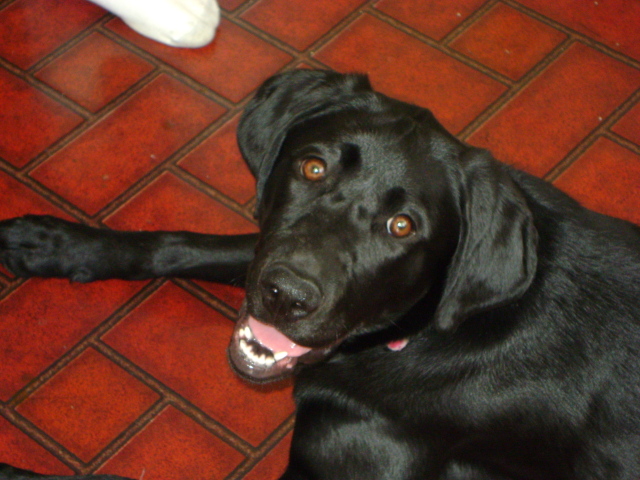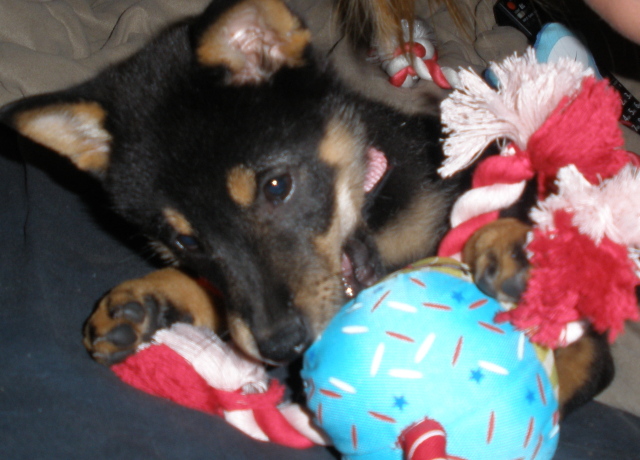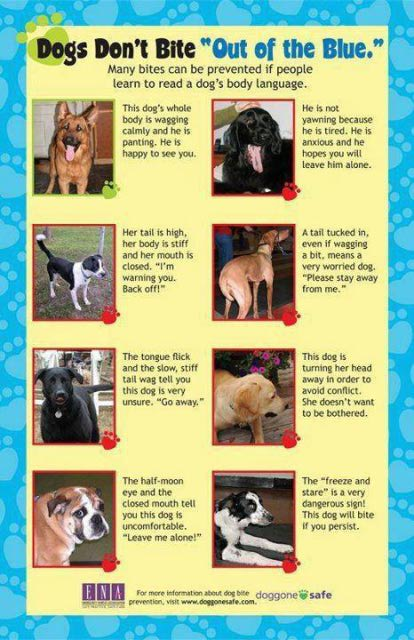Question
 Zoe
Zoe
We adopted an American foxhound three months ago from a local shelter. She is thought to be between 2-3 years old - she was kennel raised and turned into a shelter with her five puppies this past summer.
When we got her home, she was very scared and timid, but gentle and kind toward everybody, including our daughter's best friends next door, two boys ages 9 and 11.
She has learned basic commands since living with us, 'come, sit, lie down, leave it, stay, on your bed' and will not eliminate in her crate or in the house as long as she is taken out often. We cannot however allow her out of her crate for a long period of time because she will eliminate on the nearest carpet.
Our problem is twofold. First of all, after about a month with us, she started becoming very aggressive toward any visitors to the house including the boys next door, friends over for dinner, and family members staying with us. She is clearly frightened and we have tried keeping her in her crate and having our friends throw treats to her but that only works for a short bit. She is not the least bit aggressive to the three of us, (myself, my husband and my daughter, age 12) but she is increasingly aggressive toward everyone else and we are very worried about it. If she is on her leash in the house or outside, she will bark, and/or lunge and snap at people.
Secondly, we do not want to keep her in her crate indefinitely, but we do not know how to settle her into our home without her eliminating all over the house.
She is frightened of loud noises, sudden movements and all people other than us. We give her a lot of praise, we carry treats with us all the time and reward her, we try to be relaxed around her when she is scared and talk to her in upbeat voice. But there must be something we are doing wrong, or something more we should be doing. Have you got any suggestions? We realize that three months is a short time for a dog to settle into a new environment but we are increasingly worried that we do not have the skill and know-how to handle this dog.
AnswerThis is a kennel dog, having not received any socialization to households, people, activity, all the normal events on a daily basis that most dogs accept easily. She is overwhelmed. Allowing her to greet visitors so early on after adoption was an error. Having "strangers" (visitors) approach her crate and toss treats at her is another huge error. It's unlikely the dog is accepting the treats quite in the manner they are being offered: her fear is being rewarded and, worse, her "safe place" (the crate) is being breached. Stop doing that immediately. When the dog is crated, she should be LEFT ALONE by EVERYONE (especially other people's children who are visiting.)
The first rule (in my estimation) for any dog is this: your children's friends are NOT allowed to interact freely with the dog. The dog must be protected from boisterous over enthusiasm and other things children do naturally without intention to harm or frighten but that often (OFTEN) DO harm and frighten a dog. The dog is NOT their playmate. Set this rule firmly in your household; this dog is failing and will get worse unless its conditions are met unequivocally.
ONLY adults (you and your husband) should handle this dog at the front door, and you need to give her a "vacation" from the front door for a week. I don't know how you taught this dog her obedience commands, but if you are not using positive reinforcement, you must re-teach everything (but only one behavior at a time.) After this "vacation" (during which time NO ONE will interfere with her FOR ANY REASON when she is in the crate), do a setup with her at the front door. Put her on short house leash; have someone knock or ring the bell. If she begins to demonstrate anxiety (barking, lunging) at the doorbell or knock, lead her OUT of the room for a few seconds, and return to the door. Have the "visitor" repeat the knock/doorbell; leave and return until the dog no longer responds to the knock/doorbell. You must extinguish the conditioned response to the trigger (knock/doorbell) FIRST before opening the door. Although this will work in the first trial (even though it may take quite a number of knocks), you will have to repeat it later in the same day or the next day, and possibly for several days afterward (knock/doorbell, dog lunges/barks/ you leave room, return, etc.). Ok, now dog is no longer barking/lunging at knock/doorbell; ask her to "SIT" and immediately reward, then open the door. If she breaks the "sit" (and SHE WILL) close the door immediately; wait a few seconds, ask her to "sit", immediately reward, then open the door, etc. UNTIL SHE REMAINS SEATED while the "visitor" enters. If, at any time, she breaks the sit and begins to bark/lunge, take her out of the room, return, ask her to "sit", heavily praise and reward, until she is able to allow a "visitor" to enter, remain in a sit for praise/reward, without demonstrating any anxiety.
Instruct ALL VISITORS to IGNORE the dog totally while they are in your home. She is extremely anxious; until she freely approaches "visitors" by herself (and this may not happen for a long time, if at all), she is NOT in your home for the entertainment of anyone else, and this must be firmly established. She is presently demonstrating fear and anxiety at the front door; people are responding by backing up or demonstrating fear, which is teaching her more about how to control "strangers". Once she learns that barking/lunging at "strangers" at the front door is NOT working, and she has been rewarded for remaining seated while they enter, she will lose this fear response. But she may never lose anxiety and fear toward these "strangers" and should not be forced to interact with them. The KEY to managing a fearful, under socialized dog is to ask the dog to "work" for reward/praise (often) in order to establish emotional security and to protect the dog from events it cannot succeed at.
Regarding her house training, an adult kennel dog (who most likely lived in filthy conditions in the kennel) can take up to a full year to fully house train. Reward every appropriately elimination outdoors with praise and a food reward; do NOT allow this dog full run of your home, it's far too much responsibility for her and it may very well remain that way for quite a while. Confining her to the kitchen with a soft bed is fine (providing she cannot get out of the kitchen.) Give her time to understand that you WILL allow her fair opportunity to go out to eliminate (she must learn this and it will take a while), do not "correct" her for "accidents" in the house (it will only frighten her and confuse her), prevent her from soiling the carpets by not allowing her access to carpeted areas unless you are there to supervise her, and make it a habit to always reward her appropriate outdoor elimination. I've known people who have successfully house trained dogs that they have taken off the street! It can be done. Patience, consistency, fairness and affectionate leadership works every time.


 Black lab - 1 yr
QuestionSheba
QUESTION: My lab loves to bite her
Black lab - 1 yr
QuestionSheba
QUESTION: My lab loves to bite her
 Nightmares?
Question
Beethoven
Hi Melissa, Ive had my very h
Nightmares?
Question
Beethoven
Hi Melissa, Ive had my very h
 My Shiba Inu
Question
Lola
I bought a registered Shiba Inu puppy fro
My Shiba Inu
Question
Lola
I bought a registered Shiba Inu puppy fro
 Is this aggression, dominance, or play?
QuestionQUESTION: I have a question regarding doggy beh
Is this aggression, dominance, or play?
QuestionQUESTION: I have a question regarding doggy beh
 Dog light and shadow chasing
Question
Jenni
My 3 year old Cavalier King Charles Span
Dog light and shadow chasing
Question
Jenni
My 3 year old Cavalier King Charles Span